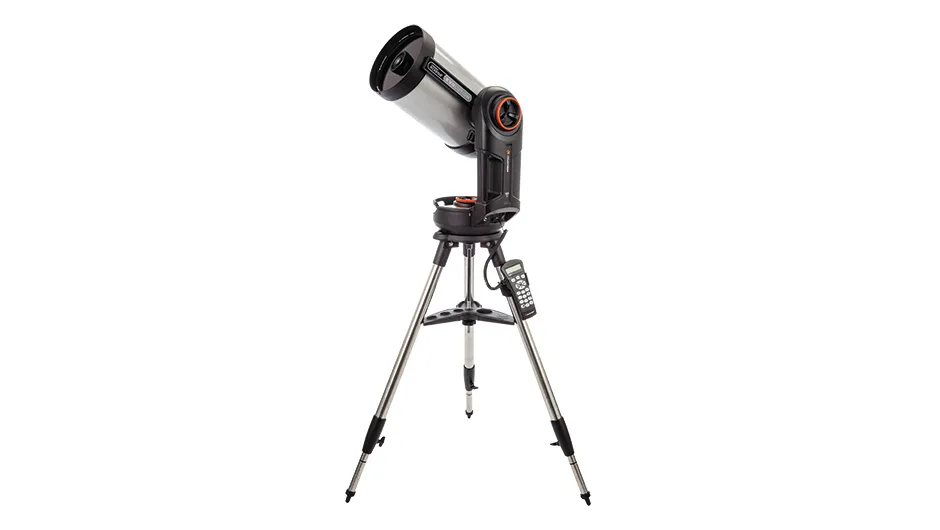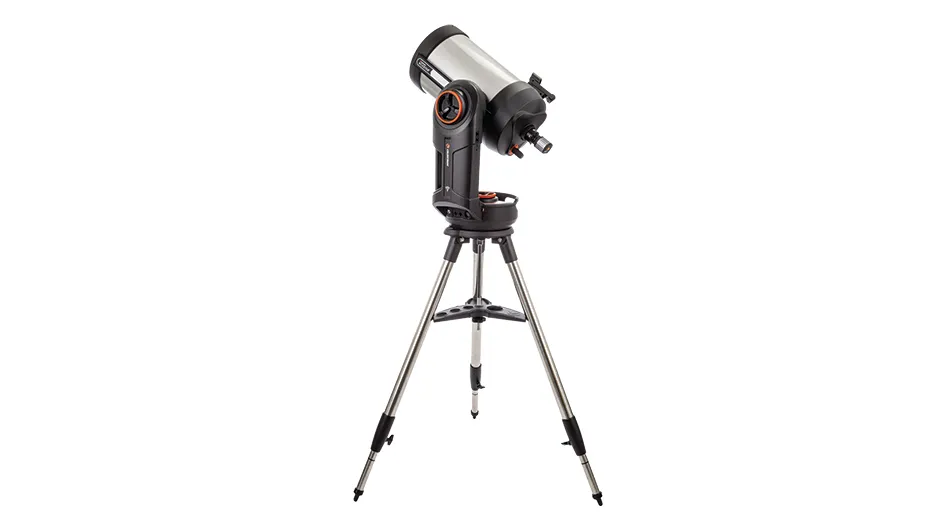Telescope innovation and improvement continues apace, nowhere more evidently than with the Celestron NexStar Evolution 8, an 8-inch Schmidt-Cassegrain telescope on a computerised single fork arm.
This altaz mount sits on a stainless steel tripod and comes with a star diagonal, Celestron’s StarPointer red-dot finderscope, 40mm and 13mm eyepieces, and a mains power cable.
The single fork arm mount has a useful carry handle, but it is within the mount’s single arm that the innovation begins.
For starters there is an integrated lithium-ion phosphate battery.
With this charged up you don’t need an external powerpack – a long overdue touch.
The mount will also function with the power cable connected.
The other innovative aspect to be hidden inside the mount is a built-in Wi-Fi network.
Using this, you can connect wirelessly with a smartphone or tablet to control the scope, although a hand controller is supplied, so tradition hasn’t been thrown completely out of the window.
This telescope features in our list of the best telescopes for kids

Although you can buy add-ons that enable other popular mounts to be controlled by a smartphone or tablet, this is the first scope to have this capability on board.
With all this hi-tech wizardry built in, assembly and basic set-up was straightforward.
We switched the mount on, connected our tablet to the SkyQLink Wi-Fi using the free Celestron SkyPortal app (available for iOS and Android) and performed the star alignment routine.
We aligned on each target with ease; most lay within the central 50 per cent of the view in the 40mm eyepiece.
Accuracy was improved by aligning with the 13mm eyepiece; after doing this, most objects were in the centre of the 40mm eyepiece, and in the 13mm they were all within the inner 50 per cent.
Optical excellence
The optics are Fastar compatible, so the secondary mirror can be replaced with a Fastar/HyperStar unit onto which a CCD camera can be mounted.
This speeds up the scope’s focal ratio by a factor of five to f/2 – especially useful for deep-sky imaging.
Our tests on Vega in Lyra revealed the optics to be very good, the bright star being pin sharp 85 per cent out from the centre of the view, with only some very slight coma present.
We picked out double star Albireo in Cygnus and enjoyed the golden and pale blue hues of its components in both 40mm and 13mm eyepieces.
Moving across the sky to Iota Cassiopeiae, we could split the triple star nicely with the 13mm eyepiece.
Within the Solar System, Saturn looked splendid, with a band visible on the planet’s disc, the Cassini division clear to see and several moons in attendance.

The nearly first quarter Moon showed off a wealth of craters and filled half of the 40mm eyepiece, showing that this accessory has a 1º field of view.
Next we toured some favourite summer deep-sky objects, with globular cluster M13, the Swan Nebula, galaxies M81 and M82, and open cluster M39 nicely filling the view with the 40mm eyepiece.
Slewing to all these targets not with a hand controller but with the planetarium interface of the SkyPortal app was simple and intuitive.
This is an altaz setup, so astrophotography is generally limited to the Moon and brighter planets; only short exposures of deep-sky objects at high ISO values are practical.
Celestron has said that an optional wedge will soon be available for long-exposure imaging.
Though the mount can be a little noisy when slewing, once tracking it is very quiet.
That aside, this is a great telescope that makes astronomy even more accessible – especially to those in tune with the latest technology.
- Price £1799.00
- Aperture 203.2mm (8 inches)
- Focal Length 2,032mm (f/10)
- Eyepieces 40mm eyepiece, 13mm eyepiece
- Mount Computerised single fork arm altaz
- Weight 18.4kg
- Supplier David Hinds
- Telephone 01525 852696
- www.celestron.uk.com
This review originally appeared in the September 2014 issue of BBC Sky at Night Magazine
